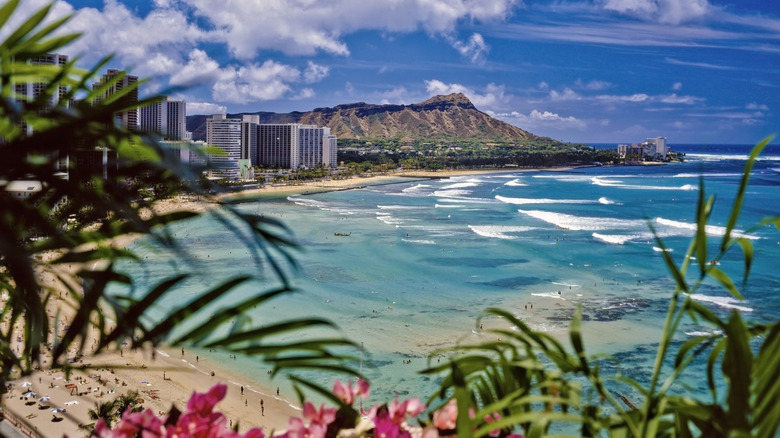Hawaii's Stunning Capital City Is Full Of Breathtaking Nature, Resorts & Historic Sights
Mention Hawaii and gorgeous beaches, volcanoes, and laid-back vibes often come to mind. From the stunning beauty of Diamond Head to crystal blue waters stretching for miles, Hawaii's capital city of Honolulu is every bit the tropical paradise for a beach vacation with a cosmopolitan twist. Over half of Hawaii's population lives in Honolulu County, making it the largest and most isolated city in the Pacific Islands. Whether you're coming to explore, get pampered, or a little of both, you'll have plenty to see and do in this diverse and beautiful city.
From the 'Iolani Palace, one of the most modern buildings in the world when it was built in 1882, to the Pearl Harbor National Memorial, Honolulu has a tremendously rich history. Since becoming the capital city of the Hawaiian Kingdom in 1845, the city has transformed into a bustling hub of art, culture, and natural beauty. Plus, it has been ranked the world's safest city to visit.
Honolulu's Daniel K. Inouye International Airport (HNL) services cities all over the United States, as well as many countries in the Asia-Pacific Rim region, including Japan, South Korea, the Philippines, Australia, and New Zealand. As with any busy city, traffic can slow to a crawl during rush hour, especially on the H-1 highway in and out of downtown Honolulu. The most efficient way to get from the airport to the city center is by ride-share or fixed-rate taxi, but bus service is also available.
The heart of Honolulu's resort district
In Honolulu, you'll find the lion's share of hotels and resorts around Waikiki, the world-famous neighborhood lined with hotels, resorts, restaurants, and plenty of shopping within walking distance of the beach. Waikiki is split into eight distinct beaches, stretching from Duke Kahanamoku Beach Park and the famous Hilton Hawaiian Village, where Elvis Presley stayed, down to Kaimana Beach near Diamond Head. In addition to the major resorts, you'll find plenty of places where you can learn to surf in the same waters where Duke Paoa Kahanamoku sharpened his skills. At his statue along Kuhio Beach, you'll find the starting point for a self-guided walking tour of Waikiki that will immerse you in the area's history.
Less than a mile west, you'll find the quieter Fort DeRussy Beach Park, perfect for a day of paddleboarding or learning about history at the U.S. Army Museum of Hawaii. The museum can validate your parking and may offer cheaper rates than other nearby parking lots. For the best views of Diamond Head and access to activities on the water, head to Royal Hawaiian Beach. Farther down the shoreline, Prince Kuhio Beach features an enclosed swimming area ideal for families with young kids.
Sadly, inflated prices and overtourism have landed Honolulu a reputation as one of the world's "most disappointing" destinations for 2025. According to Beat of Hawaii, visitors to Hawaii recently are starting to feel priced out, resulting in fewer tourists on Oahu. Nevertheless, Honolulu still offers plenty to love for those who choose to visit.
Beauty in Honolulu's backyard
To experience Hawaii's military history and beautiful nature all at once, hike up to Diamond Head State Monument. Keep in mind that non-residents must book a reservation in advance. Alternatively, Wa'ahila Ridge State Recreation Area is a lesser-known hiking gem where early Hawaiians once climbed to the top of Mt. Olympus. The Wa'ahila Ridge Trail is roughly 5 miles round-trip through forests of Cook pines, guava trees, and native plants, where you may hear the beautiful songs of white-rumped shamas. Be sure to follow the marked trail, as other paths veer onto private property. Best of all, no reservations are required and it's free to enter. Both Diamond Head and Wa'ahila Ridge are accessible by public transit — ideal for those visiting Honolulu without a car.
If you do go exploring around Honolulu, it's important to be mindful of Hawaii's fragile ecosystem and environment. The archipelago's native Ohi'a trees are suffering from "Rapid Ohi'a Death," caused by a fungus spread from tree to tree by animals or humans. Before and after hiking, be sure to disinfect your footwear soles with rubbing alcohol to prevent the disease from spreading further.


